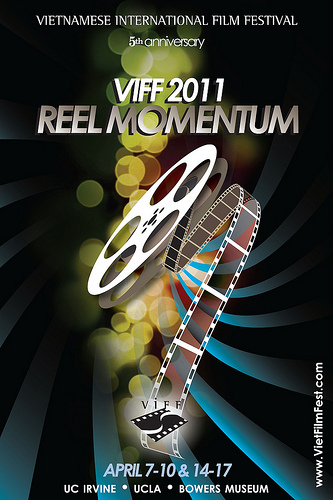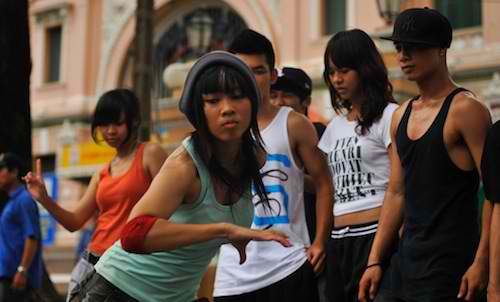In descending order, diaCRITIC Michelle Ton reviews three films shown at the 5th Biennial Vietnamese International Film Festival during April 2011 in Orange County and at UCLA. Borrowing the title of the 1966 Italian epic spaghetti western film directed by Sergio Leone, she is generous with her praise and brutally honest with her criticism as she lays out one example each of the good, the bad, and the ugly. Spoiler alert!
[before we begin: have you heard about our subscriber drive? win an iPod and other prizes!]

Yikes. A solid 4 months have gone by and I’m just now reviewing some of the films I was able to see at the 5th Biennial Vietnamese International Film Festival. My lack of timeliness can partly be chalked up to being consumed with preparing for my Master’s Comprehensive Exams, but mostly to spending time contemplating how to review some of these films in a constructive fashion (i.e. how to rephrase “It sucked and I can’t believe I drove all the way down from Los Angeles during rush hour for this.”).
A worthy exercise, indeed. Let’s begin on a high note, though, shall we?
The Good — Antoine
Laura Bari, Canada, 2010
Documentaries are hard to make. Actually, good documentaries are hard to make. Anyone can make a boring doc with tinkly piano music, and many do. Documentary filmmaking is wholly difficult in that it’s a constant juggling act of how to be educational (Latin root word for documentary is “docere” or “to teach”), how to be ethical towards subjects, and most of all, how to be entertaining for viewers. The appeal and power of a documentary lies in its eloquence in serving not just a social purpose, but an aesthetic one as well, which is why many fail when they take themselves to the task. Prima facie, a documentary concerning the life of a visually impaired little boy is a subject that has the dangerous potential to evoke a staggering amount of thematic contrivances and tacky aesthetics; the tearful talking-heads. The hand-me-down triumphing over adversity discourse. The calculated but entirely predictable dramatic musical cues that beckon our tear ducts for a release, all in service to remind us of our humanity, for making us feel good about feeling bad.
But, this is not the case with Montreal-based filmmaker, Laura Bari, and her documentary Antoine.
It is indeed a film about a boy who’s been blind since birth, but Bari’s treatment of the subject is all at once one of the most engaging, inventive forms of blurring the boundaries of fiction and reality in documentaries to date.
5-year-old Antoine Hoang spends part of his time as a gum shoe, driving around town in search for clues about a one Madame Rouski’s whereabouts who has melted into the water, according to one of her voicemails she leaves on Antoine’s mobile. And it’s up to Antoine with the aid of his two lovely assistants, Maelle and Julietta, to solve this mystery once and for all. When he’s not playing detective with his classmates, Antoine spends this time going to school, painting, reading, playing, and learning Braille reading and typing techniques.

Safe to say, it is not Antoine’s handicap that distinguishes him from his classmates, but his highly active and wondrous imagination and creativity. From the opening scene, you immediately recognize him to have a spirit and a mind unlike other children. Bari begins her documentary with an opening shot of Antoine hunched over his Braille typewriter, the blinds are closed and the room is bare except for Antoine and said typewriter. He begins to furiously tap away, creating a list of his “memories and non-memories.” In hushed voice-over, Antoine whispers to us: “I remember when I was in my mother’s belly and I remember when I was in the incubator as well.”
His non-memories? “What the incubator was made of…my retina detaching…my eyes ending up at my fingertips, my ears, my nose, my mouth. Since that day, I’ve been searching for the thread that connects my ideas.”
The documentary can’t help but be special as Antoine himself is very special. However, credit must be given to Bari and her talent for deft editing, film composition, and technical orchestrations of illusions to access and simulate Antoine’s unique perspective. Antoine’s inflections, gestures, and behavior are poetically observed and is all at once poignant, charming, and illuminative. Inspired by his imagination, Bari recreates a compelling, engaging reality using the elements of Antoine’s invention.
The Bad — Saigon Electric
Stephane Gauger, Vietnam/USA, 2011
Kind of like all those other terrible dance films, but this one has ribbons. And not that much dancing actually.
Awww. Mai wants to be a ribbon dancer and make her mama proud. The girl is in her teens, working class, and she’s strong-willed. She’s all alone in Saigon, but she’s got a dream, folks.
BUT, she has problems: her ribbon dancing ain’t all that great, so instead of training and practicing, she bides her time until her next audition by hanging out with misfit locals with their own big dreams and mediocre hip hop moves.
But oh no. The rec center where they hang out and practice their lackluster dancing has plans of being demolished by real estate developers. Luckily for them, a curmudgeon old man with an unlikely heart of gold steps in and purchases the property, saving it from destruction. In the end, our intrepid hip hop troupe, “Saigon Fresh” compete against Hanoi’s “North Killaz” in a hip hop dance competition and THIS time the South prevails! Not only that, Mai goes on that second audition of hers and totally aces her ribbon dancing routine.
Awwwww.
Trite or preposterous devices (ribbon dancing? Really?), leaden acting, and clunktastic dialogue are acceptable in a dance movie, but bad choreography is not, and it’s during the dance scenes that Saigon Electric fails. The style here is neither fun or fresh. In the battle sequences, rival dance crews borrow elements from stepping, break dancing, and popping. The problem is that the routine is amateurish, underwhelming, and poorly conceived.

All dance movies end the same way, with a training montage that builds toward the final dance-off that will secure our hero a win at said dance-off or prize money for med school or the like, or the grudging respect of the admissions officers at the exclusive ballet academy. The trick is to show enough of the training process so we can understand what our protagonist is learning, but not so much that the audience isn’t surprised and impressed by the brilliance of the resulting number. The dance sequences in Saigon Electric shirk this time-honored storytelling.
But then again, the film’s director Stephane Gauger has claimed that Saigon Electric is less a dance movie, and more so a drama.
Well, in that case: Saigon Electric is a tiresome, platinum-hearted movie with an uninspired inspirational message. Life is simple for the courageous. Our poor little girl wins in the end because she sticks to her principles and is true to her vision—yes, she is really going to become a ribbon dancer. She’s been dancing every night in her dreams, so who needs practice? How tender she is, how dewy-eyed, and passionate. Saigon Electric is all about underdogs and dance realism—where poor kids use dance to gain a foothold in a world that seems to bear some relation to our own.
My tub of popcorn had more depth.
The Ugly — Don’t Look Back
Nguyen-Vo Minh,Vietnam, 2010
Don’t Look Back is a half-baked, underachieving little movie that stands out for its egregious shoddiness, ludicrous plot, and objectionable acting/writing.
During a press conference, director Nguyen-Vo Minh (whose first feature was the yawn-inducing 2004 movie Buffalo Boy) stated that Don’t Look Back is his “commercial film” where he used it to “experiment” with this “genre.”
And what genre would that be exactly, I wonder? The “hideously bad, Art-aspiring, incompetent filmmaking” genre?
Several months ago, I wrote a diaCRITICS piece praising James Nguyen’s F grade film Birdemic for its epically bad filmmaking executions. I praised James Nguyen for the film’s many, MANY (but memorable) imperfections; I praised him for his cinematic ignorance; I praised him for his sincerity. Everything about Birdemic was bad. And everything about Don’t Look Back is bad. And yet, why are my sentiments about each movie so vastly different?
Simple. It’s because Birdemic turned out to be a fun, campy, cult-classic kind of bad movie, whereas Don’t Look Back has a miscalculated, desperate solemnity feel to it, and is too ineptly artsy and too unpleasant to be laughed off. In this case, a director’s sincerity actually works against him.
Don’t Look Back is inspired by the Greek mythology of Orpheus and the death of his wife, Eurydice, where after being allowed to bring her back from the Underworld, violates the condition of not looking back as he walks in front her during their journey back to earth. (She ends up disappearing for all eternity this time.)
Nguyen-Vo’s film tells the story of an aspiring modern dancer (sigh) who wins the heart of some two-bit saxophonist with a conspicuous cut-rate toupee. They inspire one another in their respective arts—her dancing to his saxophone playing—which make for some cringe-worthy, exasperating, WTH? moments in the movie.
But before they get to really revel in this romantic affair, she discovers that he’s a ghost and the nightclub where he plays at is actually a meeting place for the dead who get to return from the beyond thanks to the evil, capitalist proprietors (such moustache-twirlers) who are able to somehow facilitate their return back into the world. All for a monetary price, of course.

Anyway, blah blah blah, saxophone ghost dude is disappearing back into the great beyond and disappears even faster when his girlfriend looks back him. Or something like that. I don’t know. My memory is a little fuzzy either because it’s been so long since I’ve initially seen the movie or perhaps that I didn’t retain anything from this movie for reasons that have already been discussed.
Such a vast, colossal, redeem-less wasteland is this Don’t Look Back.
Did I also mention there’s modern dancing in this film? Awful.
— Michelle Ton is a Eugene V. Cota-Robles Fellow in the Department of Film, Television, and Digital Media at UCLA. She lives and works in Los Angeles.
Please take the time to rate this post (above) and share it (below). Ratings for top posts are listed on the sidebar. Sharing (on email, Facebook, etc.) helps spread the word about diaCRITICS. And join the conversation and leave a comment! What is your favorite film centering the Vietnamese experience, or made by a Vietnamese filmmaker in Vietnam or the diaspora? Anything to recommend, in any genre?



thanks for your suggestion! i will add a ‘spoiler alert’ to the intro!
I like spoilers because then I don’t have to sit out 2 hrs of my time… buuuuut I do believe that a highly visible ‘spoiler alert’ should be provided! LoL. That said, thanks for these movie reviews.